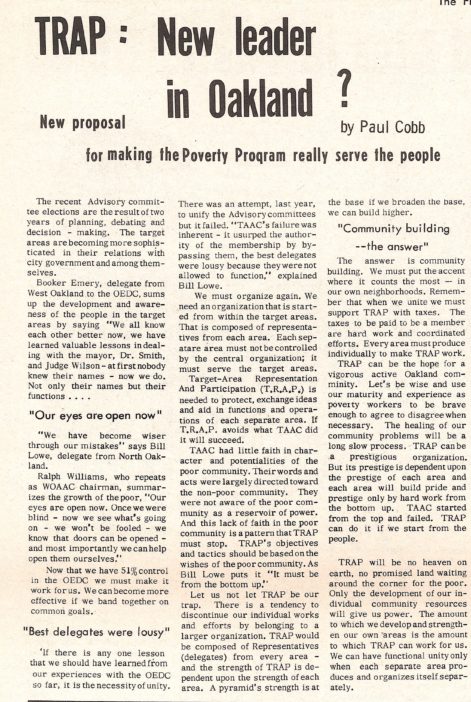Paul Cobb was a West Oakland community leader and sometime Flatlands contributor. Later in life, he would play an important role in leading the neighborhood response to the 1989 Loma Prieta earthquake, and would go on to purchase the venerable African-American newspaper The Oakland Post in 2004. In 1967 however, as he contemplated the New Year, his attention was focused on the struggle to democratize the city’s anti-poverty program and bring in greater input from the community it purported to serve.
The Target Area Advisory Committee system had been created with the intent of facilitating “maximum participation of the poor,” but federal anti-poverty officials had traditionally interpreted that dictum conservatively, preferring to cede as little power as possible to poverty workers and community members. The struggle against this federal paternalism, dramatized in the pages of The Flatlands, had occupied much of the previous year; finally, it was beginning to bear fruit. Pro-grassroots Flatlands contributors like Ralph Williams, Booker T. Emery and Bill Lowe had been elected to the West and North Oakland TAACs, and the community demand for 51% representation on the Oakland Economic Development Council (OEDC) had been successfully implemented.
Cobb articulated his vision for a grassroots, democratized poverty program through the formation of a new group—Target-Area Representation and Participation (TRAP). The group was meant to synthesize the successes and failures of the previous year’s campaigns and produce a strategy for continuing to achieve victories for the poor community they served. In his vision, TRAP’s “objectives and tactics should be based on the wishes of the poor community.” Like a pyramid, its strength would grow as its base broadened. Only through greater community engagement could TRAP achieve its goals; it offered “no promised land waiting around the corner for the poor,” but only “the development of our individual community resources [which] will give us power.”
